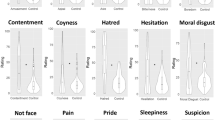Abstract
This work presents a method for designing facial interfaces for sociable android robots with respect to the fundamental rules of human affect expression. Extending the work of Paul Ekman towards a robotic direction, we follow the judgment-based approach for evaluating facial expressions to test in which case an android robot like the Geminoid|DK –a duplicate of an Original person- reveals emotions convincingly; when following an empirical perspective, or when following a theoretical one. The methodology includes the processes of acquiring the empirical data, and gathering feedback on them. Our findings are based on the results derived from a number of judgments, and suggest that before programming the facial expressions of a Geminoid, the Original should pass through the proposed procedure. According to our recommendations, the facial expressions of an android should be tested by judges, even in cases that no Original is engaged in the android face creation.
Access this chapter
Tax calculation will be finalised at checkout
Purchases are for personal use only
Preview
Unable to display preview. Download preview PDF.
Similar content being viewed by others
References
Krippendorff, K.: The semantic turn-A new foundation for design. CRC Press, Taylor & Francis Group (2006)
Grudin, J.: The computer reaches out: The historical continuity of interface design. In: Chew, J.C., Whiteside, J. (eds.) Proceedings of the SIGCHI Conference on Human Factors in Computing Systems: Empowering People (CHI 1990). ACM, NY (1990)
Dourish, P.: Where The Action Is: The Foundations of Embodied Interaction. MIT Press (2001)
Breazeal, C.: Social Interactions in HRI:The Robot View. IEEE Transactions on Systems Man, Cybernetics and Systems-Part C 34(2), 181–186 (2004)
Nishio, S., Ishiguro, H., Hagita, N.: Geminoid:Teleoperated Android of an Existing Person. In: Filho, A.C.D.P. (ed.) Humanoid Robots: New Developments, Vienna, pp. 343–352 (2007)
Reeves, B., Nass, C.: The Media Equation: How People Treat Computers, Television, and New Media Like Real People and Places. University Chicago Press (1996)
Breazeal, C.: Toward sociable robots. In: Robotics and Autonomous Systems, vol. 42(3-4), pp. 167–175. Elsevier (2003)
Picard, R.W., Klein, J.: Computers that Recognise and Respond to User Emotion: Theoretical and Practical Implications. Interacting with Computers 14(2), 141–169 (2002)
Personal Robotic Group, http://robotic.media.mit.edu/
Philips, http://www.research.philips.com/technologies/projects/robotics/
Hoffman, D.D.: Chapter 2: The Construction of Visual Reality. In: Blom, J.D., Sommer, I.E.C. (eds.) Hallucinations: Research and Practice, pp. 7–15. Springer US (2012)
Blom, J.D., Sommer, I.E.C.: Chapter 13, Hallucinations of Bodily Sensation. In: Blom, J.D., Sommer, I.E.C. (eds.) Hallucinations of Bodily Sensation, Part 2, pp. 157–169. Springer US (2012)
Ekman, P., Friesen, W.V.: Unmasking the Face – A guide to recognising emotions from facial expressions. Malor Books, Cambridge (2003)
Cohn, J.F.: Foundations of Human Computing: Facial Expression and Emotion. In: Proceedings of the 8th International Conference on Multimodal Interfaces (ICMI 2006), pp. 233–238. ACM, New York (2006)
Banissy, M.J., Ward, J.: Mirror-touch synesthesia is linked with empathy. Nature Neuroscience 10, 815–816 (2007)
Scherer, K.R.: What are emotions? And how can they be measured? Social Science Information 44(4), 695–729 (2005)
Keltner, D., Ekman, P.: Facial expression of emotion. In: Lewis, M., Jones, J.H. (eds.) Handbook of Emotions, 2nd edn., pp. 236–248. Guilford Publications, New York (2000)
Behrendt, R.P.: Consciousness, Memory, and Hallucinations. In: Blom, J.D., Sommer, I.E.C. (eds.) Hallucinations: Research and Practice, part 1, pp. 17–31. Springer US (2012)
Hanson Robotics, http://hansonrobotics.wordpress.com/
Thrun, S.: Towards A Framework for Human-Robot Interaction. Journal Human-Computer Interaction 19(1), 9–24 (2004)
Takano, E., Matsumoto, Y., Nakamura, Y., Ishiguro, H., Sugamoto, K.: The Psychological Effects of Attendance of an Android on Communication. In: Khatib, O., Kumar, V., Pappas, G.J. (eds.) Experimental Robotics. STAR, vol. 54, pp. 221–228. Springer, Heidelberg (2009)
Becker-Asano, C., Wachsmuth, I.: Affective computing with primary and secondary emotions in a virtual human. Auton. Agent Multi-Agent Systems 20(1), 32–49 (2010)
Geminoid|DK, http://www.geminoid.dk
Shimada, M., Yoshikawa, Y., Asada, M., Saiwaki, N., Ishiguro, H.: Effects of Observing Eye Contact between a Robot and Another Person. International Journal of Social Robotics 3(2), 143–154 (2011)
Padgett, C., Cottrell, G.: Representing face images for emotion classification. In: Mozer, M., Jordan, M., Petsche, T. (eds.) Advances in Neural Information Processing Systems, vol. 9. MIT Press, Cambridge (1997)
Taylor, J.: The Emerging Geographies of Virtual Worlds. Geographical Review, Cyberspace and Geographical Space 87(2), 172–192 (1997)
Turner, P.: An everyday account of witnessing. AI & Society: Special Issue: Witnessed Presence 27(1), 5–12 (2012)
Holz, T., Campbell, A.G., O’Hare, G.M.P., Stafford, J.W., Martin, A., Dragone, M.: MiRA—Mixed Reality Agents. International. Journal of Human – Computer Studies 69(4), 251–268 (2011)
The American Statistical Association, http://www.amstat.org/
Cheok, A.D., Haller, M., Fernando, O.N.N., Wijesena, J.P.: Mixed Reality Entertainment and Art. The International Journal of Virtual Reality 8(2), 83–90 (2009)
Boucher, J.D., Ekman, P.: Facial Areas and Emotional Information. Journal of Communication 25(2), 21–29 (1975)
Ekman, P.: Emotions Revealed-Understanding Faces and Feelings, Phoenix, UK (2003)
Cohn, J.F., Ekman, P.: Measuring facial action by manual coding, facial EMG, and automatic facial image analysis. In: Harrigan, J.A., Rosenthal, R., Scherer, K. (eds.) Handbook of Nonverbal Behavior Research Methods in the Affective Sciences, pp. 9–64 (2005)
Ekman, P.: Facial expression and emotion. American Psychologist 48(4), 384–392 (1993)
Picard, R.W.: Affective Computing: Challenges. International Journal of Human-Computer Studies 59(1-2), 55–64 (2003)
Carmigniani, J., Furht, B.: Augmented Reality: An Overview. In: Furht, B. (ed.) Handbook of Augmented Reality, Part 1, pp. 3–46. Springer, New York (2011)
Takeno, J., Mori, K., Naito, Y.: Robot Consciousness and Representation of Facial Expressions. In: 3rd International Conference on Sensing Technology (ICST 2008), pp. 569–574. IEEE Press (2008)
Hiroshi Ishiguro Laboratory, http://www.geminoid.jp
Vardi, M.Y.: Is Moore’s Party Over? Communications of the ACM 54(11), 5 (2011)
Author information
Authors and Affiliations
Editor information
Editors and Affiliations
Rights and permissions
Copyright information
© 2012 Springer-Verlag Berlin Heidelberg
About this paper
Cite this paper
Vlachos, E., Schärfe, H. (2012). Android Emotions Revealed. In: Ge, S.S., Khatib, O., Cabibihan, JJ., Simmons, R., Williams, MA. (eds) Social Robotics. ICSR 2012. Lecture Notes in Computer Science(), vol 7621. Springer, Berlin, Heidelberg. https://doi.org/10.1007/978-3-642-34103-8_6
Download citation
DOI: https://doi.org/10.1007/978-3-642-34103-8_6
Publisher Name: Springer, Berlin, Heidelberg
Print ISBN: 978-3-642-34102-1
Online ISBN: 978-3-642-34103-8
eBook Packages: Computer ScienceComputer Science (R0)




